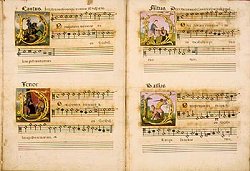Joan Pau Pujol facts for kids
Joan Pau Pujol (born in 1570, died in 1626) was a talented composer and organ player from Catalonia, Spain. He lived during a time when music was changing from the Renaissance style to the early Baroque style. While he is most famous for his church music, he also wrote popular songs for everyday people.
His Life Story
Pujol was born in a town called Mataró. In 1593, he started working as an assistant maestro de capilla (which means chapel master, a person in charge of music) at the main church in Barcelona. He only stayed there for a few months.
He then became the main chapel master at the church in Tarragona. After that, in 1595, he moved to Nuestra Señora del Pilar in Zaragoza. He worked there for 17 years. While in Zaragoza, in the year 1600, he became a priest.
In 1612, Pujol returned to Barcelona. He became the chapel master at the main church there. This was a very important job, and he kept it until he died. Most of the music he wrote comes from the time he spent in Barcelona. It seems that part of his job was to create a certain amount of new church music every year. It's special because most of his music has survived, which is rare for composers from that time.
While in Barcelona, he also gave advice about organs. He helped with different projects to build organs in Catalonia. He passed away in Barcelona.
His Music
Pujol wrote a lot of his music for St. George, who is the patron saint of Catalonia. Most of his songs were based on Gregorian chant, which is a very old style of church music.
He wrote many pieces of music, including:
- 13 masses (musical settings for church services)
- 8 settings of the Magnificat (a Christian hymn)
- 6 settings of the Nunc dimittis (another Christian hymn)
- 12 antiphons (short pieces sung before or after psalms)
- 12 responsories (pieces sung in response to something)
- 9 complete settings of the Passion (music telling the story of Jesus's suffering)
- litanies (a series of prayers)
- lamentations (songs of sorrow)
- Sequences (hymns sung in church)
- motets (choral pieces)
- hymns (religious songs)
- 74 psalm settings (music for psalms from the Bible)
He also wrote 19 sacred villancicos. These were a special type of song found only in Spain and Portugal. He also wrote popular songs that were not for church. These included romances, letrillas, liras, novenas, tonos, a folia, and 16 other pieces. Some of these were grouped together like madrigals. These songs were very popular in Spain in the early 1600s.
His missa pro defunctis (which is a Requiem mass, a service for the dead) was formal and serious. It was different from the very emotional Requiem written by his Spanish friend Tomás Luis de Victoria around the same time. Pujol's use of cantus firmus (a fixed melody used as a base) was old-fashioned. Most music using this technique was written over a hundred years before his time.
However, many of his masses and psalm settings used a style called polychoral. This means they were written for several choirs singing at the same time. This style was popular in Venice, Italy, at the time. Even though he used this newer style, his music mostly sounded like the late Renaissance period. It was not like the early Baroque style that was starting to develop in Italy and Germany.
See also
 In Spanish: Juan Pablo Pujol para niños
In Spanish: Juan Pablo Pujol para niños


